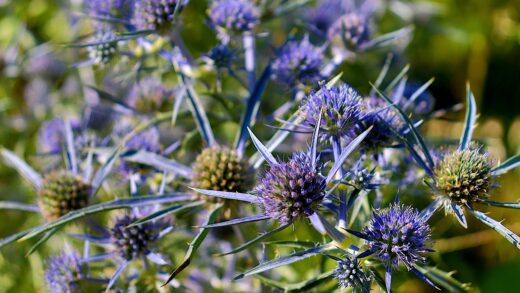While Jerusalem artichokes are known for their ability to grow in relatively poor soils, providing them with adequate nutrition is the key to unlocking their full potential and achieving a truly abundant harvest. Like any high-yielding crop, they are heavy feeders that extract a significant amount of nutrients from the soil over the course of their long growing season. A well-thought-out fertilization strategy focuses on building rich, fertile soil before planting and supplementing with the right balance of nutrients during the growing season. The goal is not just to produce tall, leafy plants, but to specifically fuel the development of large, high-quality tubers.
The foundation of any good fertility program for Jerusalem artichokes is the enrichment of the soil with organic matter. Before planting, incorporating a generous amount of well-rotted compost, aged manure, or leaf mold into the soil is the single most effective thing you can do. This not only supplies a slow-release source of a wide range of essential macro and micronutrients but also drastically improves the soil’s structure. Good structure allows for better root development, improved drainage, and increased water-holding capacity, all of which contribute to more efficient nutrient uptake by the plant. Starting with a soil that is rich in organic content provides a baseline of fertility that will support the plants throughout much of their growth.
When considering the specific nutrient needs of Jerusalem artichokes, it is helpful to think in terms of the N-P-K ratio, which represents Nitrogen (N), Phosphorus (P), and Potassium (K). While nitrogen is important for early leafy growth, an excess of it will cause the plant to produce a massive amount of foliage at the expense of the tubers. Therefore, the most critical nutrients for a good tuber harvest are phosphorus and potassium. Phosphorus plays a vital role in root development and energy transfer within the plant, while potassium is essential for the process of photosynthesis and the transportation of sugars from the leaves to the tubers for storage, which directly influences tuber size and density.
A balanced approach to fertilization is therefore essential. An initial soil preparation with compost provides a good all-around start. If supplemental fertilization is needed during the growing season, particularly in less fertile soils, it is best to choose a fertilizer that has a lower nitrogen value and higher phosphorus and potassium values. This could be an organic option like bone meal (for phosphorus) and wood ash or kelp meal (for potassium), or a balanced synthetic fertilizer formulated for root vegetables. Applying this supplemental fertilizer mid-season, around the time you would be hilling the plants, can provide a welcome boost just as the plant begins to think about forming its tubers.
General fertility needs
Jerusalem artichokes are robust plants with a substantial appetite for nutrients, driven by their rapid growth and the large biomass they produce both above and below ground. Their general fertility needs are balanced, but with a specific emphasis on minerals that support root and tuber development over excessive foliage. The plant’s primary requirement is for a soil that is rich in organic matter. This provides a complex, slow-release source of nutrients and supports a healthy soil microbiome, which in turn helps to make minerals more available to the plant’s roots. A soil with an organic content of at least 5% is an excellent starting point for cultivating a productive patch.
More articles on this topic
In terms of macronutrients, the plant requires a steady supply of nitrogen, phosphorus, and potassium throughout its life cycle. Nitrogen is crucial in the initial stages of growth, fueling the rapid development of the tall stalks and the vast canopy of leaves that are needed for photosynthesis. However, this need for nitrogen tapers off as the season progresses. An overabundance of nitrogen, especially later in the season, is detrimental as it signals the plant to continue focusing on green growth, resulting in impressively tall plants but a disappointing harvest of small tubers. The key is to provide enough nitrogen for a strong start, but not so much that it overshadows the need for other key nutrients.
Phosphorus is fundamentally important for the overall health and energy of the plant. It is a key component in root development, which is critical for a plant that needs to anchor its tall stalk and forage for water and nutrients. Furthermore, phosphorus is essential for the processes of energy transfer within the plant, which is vital when the plant begins the energy-intensive task of forming and filling its tubers. A deficiency in phosphorus can lead to stunted growth and poor tuber formation, even if other nutrients are plentiful. Sources rich in phosphorus, such as bone meal or rock phosphate, can be beneficial amendments in soils that are known to be deficient.
Potassium is arguably the most critical nutrient for maximizing the tuber yield of Jerusalem artichokes. This mineral acts as a regulator for many of the plant’s internal processes, including photosynthesis and, most importantly, the translocation of sugars and starches from the leaves down to the tubers for storage. A sufficient supply of potassium leads directly to larger, denser, and better-quality tubers. Soils that are deficient in potassium will produce plants that may look healthy above ground but will fail to deliver a substantial harvest. Organic sources of potassium include wood ash (used sparingly and with attention to soil pH), greensand, and kelp meal.
The role of macronutrients
The three primary macronutrients—nitrogen (N), phosphorus (P), and potassium (K)—each play a distinct and crucial role in the growth and development of the Jerusalem artichoke. Nitrogen is the engine of vegetative growth, responsible for the vibrant green color of the leaves and the rapid elongation of the stalks. In the early part of the growing season, an adequate supply of nitrogen is essential for the plant to build its “factory”—the large leaf canopy required to capture sunlight for photosynthesis. Without enough nitrogen, plants will appear pale, spindly, and stunted. However, the application of nitrogen must be carefully managed, as too much, too late will keep the plant in a vegetative state, hindering the switch to tuber production.
More articles on this topic
Phosphorus (P) is often referred to as the “energy” nutrient, and its role is foundational for a healthy Jerusalem artichoke plant. It is vital for the early establishment of a strong and extensive root system, which is the plant’s anchor and its primary means of absorbing water and all other nutrients. Phosphorus is a key component of ATP (adenosine triphosphate), the molecule that carries energy throughout the plant. This energy is required for all metabolic processes, including the complex conversion of solar energy into the starches that will eventually be stored in the tubers. A steady supply of phosphorus ensures the plant has the energy reserves needed for the demanding task of tuber formation.
Potassium (K) is the “quality” nutrient, having a direct impact on the size, density, and storage quality of the tubers. Its primary role is to regulate the movement of water, nutrients, and carbohydrates within the plant’s tissues. Specifically for tuber development, potassium facilitates the transport of sugars produced in the leaves during photosynthesis down to the underground tubers for storage as inulin. A plentiful supply of potassium ensures this process is highly efficient, resulting in larger, more substantial tubers. Potassium also helps to strengthen the plant’s cell walls, making it more resilient to stress from drought, temperature extremes, and disease.
Understanding the balanced interplay of these three macronutrients is key to a successful fertilization strategy. The ideal approach provides sufficient nitrogen for initial growth, followed by an increasing emphasis on phosphorus and potassium as the season progresses towards the tuber-forming stage. This is why organic amendments like compost are so effective, as they release nutrients slowly and in a relatively balanced way. When using supplemental fertilizers, choosing one with a ratio that favors P and K, such as a 5-10-10 or a 3-9-6 formulation, is far more beneficial for Jerusalem artichokes than a high-nitrogen lawn fertilizer, for example.
Organic fertilization strategies
For the cultivation of Jerusalem artichokes, an organic fertilization strategy is not only sustainable but also highly effective, as it focuses on building long-term soil health. The cornerstone of this approach is the liberal use of compost. Well-finished compost is the single best soil amendment, providing a balanced profile of macro and micronutrients in a stable, slow-release form. It should be incorporated into the bed before planting, and can also be used as a top-dressing or side-dressing during the growing season. Compost feeds the plant, improves soil structure, increases microbial activity, and enhances the soil’s ability to retain moisture, creating the perfect environment for tuber development.
Another excellent organic option is the use of well-rotted animal manures, such as those from cows, horses, or chickens. It is crucial that the manure is properly aged or composted before application, as fresh manure is too high in nitrogen and can burn the plants’ roots. Aged manure provides a rich source of nutrients and organic matter. It is best applied in the autumn prior to spring planting, giving it time to break down and integrate into the soil over the winter. This method provides a deep reserve of fertility for the heavy-feeding Jerusalem artichoke crop to draw upon throughout the following season.
To target specific nutrient needs, various other organic amendments can be utilized. For a phosphorus boost, which is crucial for root and tuber development, bone meal or rock phosphate can be mixed into the soil at planting time. For potassium, which is vital for tuber sizing, sources like greensand, kelp meal, or wood ash are effective. Wood ash is particularly high in potassium but is also alkaline, so it should be used with caution and only in acidic soils, and never in large quantities. These targeted amendments allow you to tailor the soil’s nutrient profile to the specific needs of a root crop like the Jerusalem artichoke.
Cover cropping is a more advanced organic strategy that can pay huge dividends for the long-term fertility of your Jerusalem artichoke patch. Planting a “green manure” crop like clover, vetch, or winter rye in the autumn after harvesting can protect the soil from erosion over winter. In the spring, this cover crop is tilled back into the soil, where it decomposes and releases a significant amount of organic matter and nutrients. Leguminous cover crops like clover and vetch have the added benefit of “fixing” atmospheric nitrogen in the soil, providing a natural and free source of this essential nutrient for the upcoming Jerusalem artichoke crop.
Recognizing nutrient deficiencies
Identifying nutrient deficiencies in Jerusalem artichokes can be challenging, as the plant is so vigorous that it can often mask minor issues. However, careful observation can reveal signs that the soil is lacking in certain key elements. A general nitrogen deficiency is one of the easiest to spot. Plants will exhibit slow, stunted growth, and the leaves, particularly the older, lower ones, will turn a pale, uniform yellow (a condition known as chlorosis). This happens because the plant is mobile with its nitrogen, moving the nutrient from older leaves to support new growth. If you see widespread yellowing and weak growth, it is a clear sign that more nitrogen is needed.
A phosphorus deficiency often manifests in more subtle ways. The plants may be stunted, but the most characteristic sign is an unusual dark green or even purplish discoloration of the leaves, especially on younger plants. This is because the lack of phosphorus inhibits many of the plant’s metabolic processes, including the proper formation of chlorophyll. Growth will be slow, and root development will be poor, which ultimately leads to a significantly reduced tuber yield. Since phosphorus is not mobile in the soil, it’s a deficiency that is best addressed by amending the soil with sources like bone meal before planting.
Potassium deficiency can be particularly detrimental to the final harvest. The most common visual symptom is the yellowing of the margins, or edges, of the leaves, starting with the lower and middle leaves on the stalk. The center of the leaf may remain green while the edges look scorched or burnt. The plant may also have weak stalks and a general lack of vigor. Because potassium is crucial for water regulation and disease resistance, deficient plants may be more susceptible to drought stress and fungal diseases. The most significant sign of a potassium shortage, however, is a harvest of numerous but disappointingly small and lightweight tubers.
When you suspect a nutrient deficiency, it is important to consider other factors before adding fertilizer. Poor drainage, soil compaction, or an incorrect soil pH can all “lock up” nutrients in the soil, making them unavailable to the plant even if they are physically present. Therefore, before diagnosing a deficiency, check your soil’s moisture and tilth. For persistent problems, a professional soil test is the most accurate way to determine the nutrient content and pH of your soil. This allows you to address the specific needs of your patch with targeted amendments, ensuring your fertilization efforts are both effective and efficient.


















